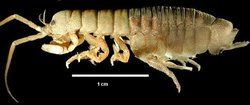Malacostraca
|
|
| Malacostraca | ||||||||
|---|---|---|---|---|---|---|---|---|
 Eophreatoicus (a fresh water isopod from Australia) | ||||||||
| Scientific classification | ||||||||
| ||||||||
| Orders | ||||||||
|
Subclass Eumalacostraca Subclass Hoplocarida Subclass Phyllocarida |
The Malacostraca are the largest subgroup of crustaceans and include most of the animals that non-experts recognise as crustaceans, such as the decapods (such as crabs, mole crabs, lobsters and true shrimps), the stomatopods or mantis shrimps, and krills. They also include the huge group of amphipods, and the only substantial group of land-based crustaceans, the isopods (woodlice or sowbugs and related species). With more than 22'000 members, this group represents two third of all crustacean species and contains all the larger forms. It first appeared in the Cambrian.
The classification of crustaceans is currently being debated, and the Malacostraca are regarded by some authors as a class and by others as a subclass.
Morphology
Their characteristics include:
- The head has 6 segments, with a pair of antennules and a pair of anntennae, as well as mouthparts.
- They have 5 pairs of walking legs, with the first often modified to form pincers.
- There are 8 thoracic segments. The cephalothorax is covered by a carapace form via fusion of 3 of them, letting the 5 other uncovered.
- The abdomen is behind and often used for swimming. There are 6 abdominal segments.
- There are appendages near the mouthparts, these are called maxillipeds.
- They have compound stalked or sessile eyes.
- They have two-chambered stomach.
- They have a centralised nervous system.da:Storkrebs
